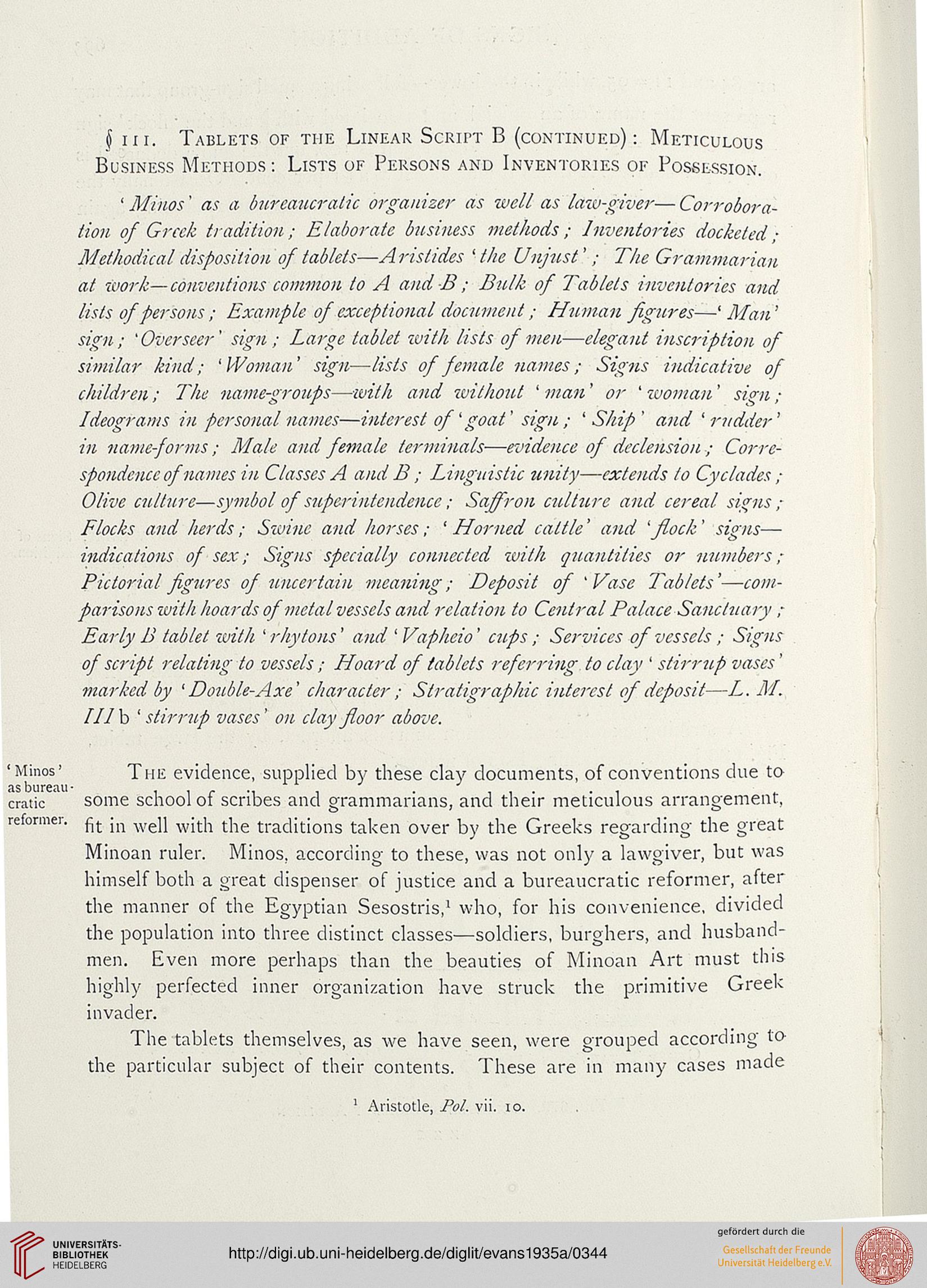I in. Tablets of the Linear Script B (continued): Meticulous
Business Methods: Lists of Persons and Inventories of Possession.
' Miuos' as a bureaucratic organizer as wall as law-giver— Corrobora-
tion of Greek tradition; Elaborate business methods; Inventories docketed '■
Methodical disposition of. tablets—Arislides ' the Unjust'; The Grammarian
at work—conventions common to A aud-B; Bulk of Tablets inventories and
lists of persons ; Example of exceptional document; Human figures—' Man'
sign; 'Overseer' sign ; Large tablet with lists of men—elegant inscription of
similar kind; 'Woman' sign—lists of female names; Signs indicative of
children; The name-groups—with and without ' man' or ' woman' sign ;
Ideograms in personal names—interest of 'goat' sign ; ' Ship ' and ' rudder'
in name-forms; Male and female terminals—evidence of declension; Corre-
spondence of names in Classes A and B ; Linguistic unity—extends to Cyclades ;
Olive culture—symbol of superintendence; Saffron culture and cereal signs;
Flocks and herds; Swine and horses; ' Homed cattle' and 'flock' signs—
indications of sex; Signs specially connected with Quantities or numbers;
Pictorial figures of uncertain meaning; Deposit of ' Vase Tablets'—com-
parisons with hoards of metal vessels and relation to Central Palace Sanctuary ;
Early B tablet with ' rhytons' and ' Vapheio' cups ; Services of vessels ; Signs
of script relating to vessels ; Hoard of tablets referring to clay ' stirrup vases'
marked by ' Double-Axe' character; Stratigrapliic interest of deposit—Z. M.
IH b ' stirrup vases' on clay floor above.
The evidence, supplied by these clay documents, of conventions due to
some school of scribes and grammarians, and their meticulous arrangement,
fit in well with the traditions taken over by the Greeks regarding the great
Minoan ruler. Minos, according to these, was not only a lawgiver, but was
himself both a great dispenser of justice and a bureaucratic reformer, after
the manner of the Egyptian Sesostris,1 who, for his convenience, divided
the population into three distinct classes—soldiers, burghers, and husband-
men. Even more perhaps than the beauties of Minoan Art must this
highly perfected inner organization have struck the primitive Greek
invader.
The tablets themselves, as we have seen, were grouped according to
the particular subject of their contents. These are in many cases made
1 Aristotle, Pol. vii. 10.
Business Methods: Lists of Persons and Inventories of Possession.
' Miuos' as a bureaucratic organizer as wall as law-giver— Corrobora-
tion of Greek tradition; Elaborate business methods; Inventories docketed '■
Methodical disposition of. tablets—Arislides ' the Unjust'; The Grammarian
at work—conventions common to A aud-B; Bulk of Tablets inventories and
lists of persons ; Example of exceptional document; Human figures—' Man'
sign; 'Overseer' sign ; Large tablet with lists of men—elegant inscription of
similar kind; 'Woman' sign—lists of female names; Signs indicative of
children; The name-groups—with and without ' man' or ' woman' sign ;
Ideograms in personal names—interest of 'goat' sign ; ' Ship ' and ' rudder'
in name-forms; Male and female terminals—evidence of declension; Corre-
spondence of names in Classes A and B ; Linguistic unity—extends to Cyclades ;
Olive culture—symbol of superintendence; Saffron culture and cereal signs;
Flocks and herds; Swine and horses; ' Homed cattle' and 'flock' signs—
indications of sex; Signs specially connected with Quantities or numbers;
Pictorial figures of uncertain meaning; Deposit of ' Vase Tablets'—com-
parisons with hoards of metal vessels and relation to Central Palace Sanctuary ;
Early B tablet with ' rhytons' and ' Vapheio' cups ; Services of vessels ; Signs
of script relating to vessels ; Hoard of tablets referring to clay ' stirrup vases'
marked by ' Double-Axe' character; Stratigrapliic interest of deposit—Z. M.
IH b ' stirrup vases' on clay floor above.
The evidence, supplied by these clay documents, of conventions due to
some school of scribes and grammarians, and their meticulous arrangement,
fit in well with the traditions taken over by the Greeks regarding the great
Minoan ruler. Minos, according to these, was not only a lawgiver, but was
himself both a great dispenser of justice and a bureaucratic reformer, after
the manner of the Egyptian Sesostris,1 who, for his convenience, divided
the population into three distinct classes—soldiers, burghers, and husband-
men. Even more perhaps than the beauties of Minoan Art must this
highly perfected inner organization have struck the primitive Greek
invader.
The tablets themselves, as we have seen, were grouped according to
the particular subject of their contents. These are in many cases made
1 Aristotle, Pol. vii. 10.





